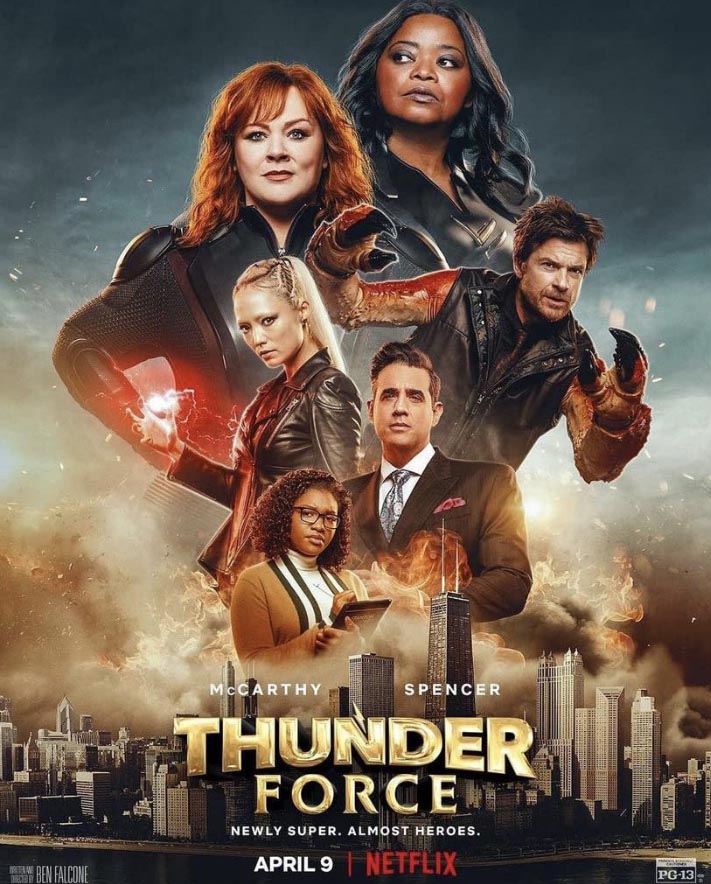There’s a scene in “Thunder Force” that’s been on my mind since I saw it. Two high-school friends, Lydia and Emily, have recently reunited after a decades-long estrangement. Lydia (Melissa McCarthy) is a blue-collar stereotype – a forklift worker, with a penchant for beer and videogames and sports. Emily (Octavia Spencer) is a prim, super-smart scientist. The scene in question hinges on Lydia’s introduction to Tracy, Emily’s teenaged daughter, just as prim and smart as her mother. Before the introduction, though, Emily glances at the teenager and compares her to Urkel.
It’s a trite reference to Steve Urkel, the symbol of all things black and nerdy of the 90s. Mother and daughter are baffled by the reference. Fair enough. Anyone born in this century might struggle to know what “Family Matters” is. The gag, painfully continues though. Emily pulls up her device, “How do you spell that?” McCarthy performs a riff on Jaleel White’s Urkel to blank stares. The moment is set up like a joke. It has the bare bones rhythm of something like a joke but it plays as anything but. There’s already the strangeness that Lydia, but not Emily, gets the reference to Steve Urkel. But it’s not really the joke itself. The scene is constructed without any discernible comedic rhythm or energy of any kind. It’s quickly stymied by a moment of dramatic realisation that pivots into another “gag” (this time McCarthy, in another painful bit as Jodie Foster in “Nell”) and all the while I kept wondering, “Is this what comedy has come to?”
“Thunder Force”, the most recent collaboration between writer-director Ben Falcone and his wife Melissa McCarthy, finished principal photography in December 2019, and was released to audience earlier this month. Presumably, the more than 16 months since production wrapped were necessary for the post-production effects of the superhero comedy film (or “comedy” film) which follows two childhood friends who become superheroes in adulthood to fight crime in a world where criminals have developed into supervillains.
“Thunder Force” is not good. Fair enough, but it’s not even so much a badness that comes out of bad efforts as it is a general listlessness that comes out of what seems to be little effort. The film opens with some exposition. In 1983, interstellar cosmic-rays struck the earth and triggered genetic transformation in some people. Unfortunately for the world, they were only triggered in persons genetically predisposed to sociopathy. And so, a league of supervillains was born. Amidst this, newly orphaned Emily makes friends with the boisterous Lydia. Their friendship is threatened by Lydia’s laziness and Emily’s drive. They part ways. We meet them again in the future (somewhere between 20 and 35 years – it’s hard to ascertain when). Movie hijinks require them to reunite, and they do. Emily is on the cusp of genetically transforming humans into superheroes. Lydia accidentally injects herself with one of the serums and the two become a reluctant crime-fighting duo.
If that relaying of the plot feels perfunctory in paragraph form, the film treats it even more ham-fistedly on screen. Falcone lobs globs of exposition at the audience as inorganically as can be. The barebones ideas for the film depend on establishing key bits of information, but there is no filmic savvy or cinematic flare here. Instead, there is an indolent ambivalent as key bits of information are checked off, as if from a list. It’s fascinating to watch, because it feels like we’re watching an assembly-line version of a movie that might become a real movie somewhere down the line. The energy on display is dismally low.
Why did anyone make this? That’s the question I kept mulling on as I watched “Thunder Force” in a kind of awed state of bafflement. To be fair, much of the previous output from Falcone and McCarthy has been less than rewarding but it’s (just) that “Thunder Force” is not very good, it’s that “Thunder Force” seems wholly indifferent to its own existence. McCarthy’s penchant for being earnest, even in the face of bad material, seems oddly neutered here. Spencer’s natural ebullience seems dimmed. The super villain arc that begins to take shape centres on Bobby Cannavale as an evil politician in the kind of generic performance that would be dull elsewhere but here feels at least committed.
The closest things to good performances are Melissa Leo in a throwaway role as a CIA operative working for Emily and Jason Bateman as a crab-man who begins an effortful romance with Lydia. They are the closest things to good, but neither performance is following an arc that offers much joy. There’s no joy in “Thunder Force”. Not in the squandered potential of watching McCarthy and Spencer riff off each other. Not in the squandered potential of subverting our current reality of superhero fare in media. Not in the squandered potential of a gentle comedy, that charms in its diffidence. Instead, it’s dull and perfunctory and listless and altogether incredibly dismal. It’s shot in the same kind of lethargic assembly-line way that has little distinguishing visual cues and sloppy editing that kills any potential momentum.
The fact that “Thunder Force” finished primary shooting before the COVID-19 pandemic did give me a sense of relief. Knowing that none of the parties involved risked their health to complete it is the only saving grace of the film’s dismal energy, and yet I would have understood if it were made in the middle of the pandemic since that would explain the almost aggressive lackadaisical nature of the film that we are left with.
Thunder Force is streaming on Netflix.






